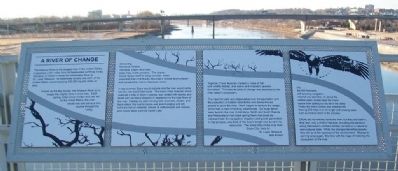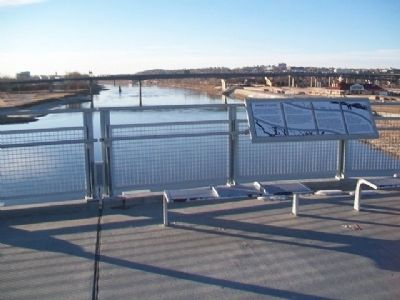Downtown in Omaha in Douglas County, Nebraska — The American Midwest (Upper Plains)
A River of Change
The Missouri River is the longest river in the United States. It stretches 2,341 miles from its headwaters at Three Forks, Montana, to where it meets the Mississippi River at St. Louis, Missouri. Its watershed covers one-sixth of the United States, encompassing 530,000 square miles of land.
Known as the Big Muddy, the Missouri River is no longer the mighty force it once was. Each spring, when snow melted and rain fell on the Great Plains, the river would rise and carve a new course through the valley devouring farmland, forests, railroads, towns and even state lines in the process. The scene would repeat itself in early summer, when snowmelt from the Rocky Mountains flowed downstream and caused the river to rise even more.
In late summer, flows would subside and the river would settle into the new bed it had made. The river's main channel, which spanned a mile or more in places, was dotted with islands and laced with sandbars stripped of vegetation by the high flows of the river. Flanked by slow-moving side channels, chutes, and backwaters, the river's course was everchanging and left behind a trail of wetlands, forests of cottonwoods and willows, and oxbow lakes such as Carter Lake.
Together, these features created a maze of fish and wildlife habitat, and native and migratory species flourished. This natural cycle of change was essential to the river valley's ecosystem.
The need for safe and dependable river transportation and the protection of bottom-land farms and towns moved people to tame the river. Work began to remove the snags, which had a habit of sinking steamboats. Six huge dams were built on the river in Montana, North and South Dakota and Nebraska to hold back spring flows that could be released later for navigation, irrigation and power generation. In the process, one-third of the river's length was turned into reservoirs. The lower third of the river from Sioux City, Iowa to St. Louis, Missouri was forced into the 600-foot-wide, self-scouring navigation channel you see here. In all but the wettest years, levees keep the river's waters from spilling out too far in the valley. Finally, the river's course was straightened, shaving 205 miles from its length and creating lakes such as Desoto Bend in the process.
Efforts did not entirely tame the river, but they did leash it. And now, only a third of the river, including two sections along Nebraska's northern border, remains in a natural or semi-natural state. While the changes benefited society, they did so at the expense of the environment. Change is coming once again, this time with the hope of restoring the ecosystem of the river.
Topics. This historical marker is listed in these topic lists: Animals • Charity & Public Work • Waterways & Vessels.
Location. 41° 15.934′ N, 95° 55.359′ W. Marker is in Omaha, Nebraska, in Douglas County. It is in Downtown. Marker is near the center of the Bob Kerrey Pedestrian Bridge across the Missouri River, off Riverfront Drive. Touch for map. Marker is in this post office area: Omaha NE 68102, United States of America. Touch for directions.
Other nearby markers. At least 8 other markers are within walking distance of this marker. A River of Hope (within shouting distance of this marker); Westwardly by the Waters (about 400 feet away, measured in a direct line); the Council was held (about 400 feet away); Capt. Lewis…will…give us accounts of new things only (about 400 feet away); endeavor to make yourself acquainted…with…the nations (about 400 feet away); Nature exerted herself to butify the Senery (about 500 feet away); People, Places, and Stories (about 600 feet away); Preserving Our Heritage (about 600 feet away). Touch for a list and map of all markers in Omaha.
Also see . . .
1. Missouri National Recreation River Water Trail. (Submitted on March 2, 2014, by William Fischer, Jr. of Scranton, Pennsylvania.)
2. Missouri National Recreational River. (Submitted on March 2, 2014, by William Fischer, Jr. of Scranton, Pennsylvania.)
3. Missouri River Institute. (Submitted on March 2, 2014, by William Fischer, Jr. of Scranton, Pennsylvania.)
Credits. This page was last revised on February 16, 2023. It was originally submitted on March 2, 2014, by William Fischer, Jr. of Scranton, Pennsylvania. This page has been viewed 530 times since then and 11 times this year. Photos: 1, 2. submitted on March 2, 2014, by William Fischer, Jr. of Scranton, Pennsylvania.

